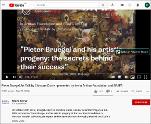Pieter Bruegel and his artistic progeny: The secrets behind a successful dynasty

View/
Authors
Currie, Christina
Discipline
Arts
Subject
Pieter Brueghel the Younger
Pieter Bruegel the Elder
Technical art history
Audience
Scientific
General Public
Date
2018-11-27Metadata
Show full item recordDescription
This lecture was given at the In Artibus Foundation in Moscow in November 2018.
The Bruegel dynasty, initiated by the great Pieter Bruegel the Elder, produced large numbers of paintings that are still hugely popular with art lovers and collectors today. This talk explores its founder’s work from a stylistic and technical point of view, providing close-up glimpses into his supreme virtuosity as a painter. But the bulk of the lecture concentrates on the fascinating phenomenon of the copies of Bruegel the Elder’s works, which were reproduced in vast numbers by his elder son Pieter and to a lesser extent his younger son Jan at the end of the sixteenth and first part of the seventeenth century. Precisely how the sons were able to imitate their father’s works with such exactitude, even when they couldn’t see them with their own eyes, is revealed.
The talk also touches on the tricky subject of attribution. In the seventeenth century, such was the renown of Bruegel the Elder that many anonymous imitators made their living by reproducing his popular scenes. Today, the art market abounds with Bruegel style paintings and it sometimes takes a forensic approach to distinguish between genuine paintings originating in Pieter Brueghel the Younger’s workshop and those of contemporaries and later imitators. Dr Currie, thanks to her in-depth technical study of around a hundred works by Brueghel the Younger, is able to make this distinction, using state-of-the-art technology such as infrared reflectography and X-radiography but also through old-fashioned connoisseurship.
Citation
Christina Currie, ‘Pieter Bruegel and his artistic progeny : The secrets behind a successful dynasty’, lecture, Artibus Foundation, Moscow, Russia, 26 and 27 October 2018, URL: https://www.youtube.com/watch?v=boatN5CL1Qw (last accessed: 3 June 2021).
Identifiers
Type
Lecture
Peer-Review
Not pertinent
Language
eng
